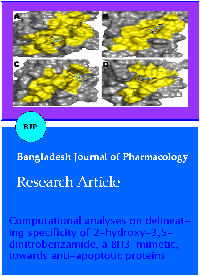Computational analyses on delineating specificity of 2-hydroxy-3,5-dinitrobenzamide, a BH3-mimetic, towards anti-apoptotic proteins
DOI:
https://doi.org/10.3329/bjp.v9i3.18965Keywords:
Anti-apoptotic protein, Bcl-2 family, BH3-mimetic, 2-hydroxy-3, 5-dinitrobenzamideAbstract
We have herein computationally examined binding affinities and specificity of 2-hydroxy-3,5-dinitrobenzamide (HDNB), a small chemical molecular BH3-mimetic identified by means of peptidodynmimetic method, on the BH3-binding grooves of six anti-apoptotic proteins (Bcl-2, Bcl-B, Bcl-W, Bcl-XL, Bfl-1 and Mcl-1) from human beings. The HDNB ligand was found to interact on the BH3-binding grooves of Bcl-2, Bcl-B, Bcl-XL, Bfl-1 and Mcl-1, whereas it did not act as BH3-mimetic to Bcl-W. Moreover, binding affinities of the HDNB towards the anti-apoptotic proteins were significantly different from each other. The differential binding affinities and specificity of the HDNB towards the anti-apoptotic proteins have been chiefly attributed to the differences in the chemical properties of BH3-binding grooves of the proteins. Implications of the study to design efficient de novo antagonists to the anti-apoptotic proteins using the HDNB as seed molecule have been discussed.
Downloads
348
283 Read
29
References
Bernardo PH, Wan K, Sivaraman T, Xu J, Moore FK, Hung AW, Mok HYK, Yu VC, Chai CLL. Structure-Activity Relationship Studies of phenanthridine-based Bcl-XL inhibitors. J Med Chem. 2008; 51: 6699-710.
Bernardo PH, Sivaraman T, Wan K, Xu J, Krishnamoorthy J, Sons CM, Tian L, Chin JSF, Lim DSW, Mok HYK, Yu VC, Tong JC, Chai CLL. Structural insights into the design of small molecule inhibitors that selectively antagonize mcl-1. J Med Chem. 2010; 53: 2314-18.
Bernardo PH, Sivaraman T, Wan KF, Xu J, Krishnamoorthy J, Song CM, Tian L, Chin JS, Lim DS, Mok HY, Yu VC, Tong JC, Chai CL. Synthesis of a rhodanine-based compound library targeting Bcl-XL and Mcl-1. Pure Appl Chem. 2011; 83: 723-31.
Ke N, Godzik A, Reed JC. Bcl-B, a Novel Bcl-2 family member that differentially binds and regulates Bax and Bak. J Biol Chem. 2001; 276: 12481-84.
Kelly PN, Strasser A. The Role of Bcl-2 and its pro-survival relatives in tumourigenesis and cancer therapy. Cell Death Differ. 2011; 18: 1414-24.
Labi V, Grespi F, Baumgartner F, Villunger A. Targeting the Bcl-2-regulated apoptosis pathway by BH3 mimetics: A breakthrough in anticancer therapy? Cell Death Differ. 2008; 15: 977-87.
Lessene G, Czabotar PE, Colman PM. Bcl-2 family antagonists for cancer therapy. Nat Rev Drug Discov. 2008; 7: 989-1000
Li XB, Wang SQ, Xu WR, Wang RL, Chou KC. Novel inhibitor design for hemagglutinin against H1N1 influenza virus by core hopping method. PLoS One. 2011; 6: e28111.
Liang H, Fesik SW. Three-dimensional structures of proteins involved in programmed cell death. J Mol Biol. 1997; 274: 291-302.
Placzek WJ, Wei J, Kitada S, Zhai D, Reed JC, Pellecchia M. A survey of the anti-apoptotic Bcl-2 subfamily expression in cancer types provides a platform to predict the efficacy of Bcl-2 antagonists in cancer therapy. Cell Death Dis. 2010; 1: e40.
Rajesh SS, Gorai B, Sivaraman T. Computational designing of novel inhibitors to Bcl-B, an anti-apoptotic protein, using fragment-based drug designing approach. Rom Biotechnol Lett. 2013; 18: 8613-21.
Rajesh SS, Sivaraman T. Cheminformatic designing of de novo inhibitors to 3-methyl adenine DNA glycosylase I (LiTagA) from Leptospira interrogans serovar lai strain 56601. Med Chem Res. 2013; 22: 3434-43.
Reed JC. Bcl-2–family proteins and hematologic malignancies: History and future prospects. Blood 2008; 111: 3322-29.
Schreiber G, Keating AE. Protein binding specificity versus promiscuity. Curr Opin Struct Biol. 2011; 21: 50-61.
Sivakumar D, Aashis R, Sivaraman, T. In silico rationalization for the differential bioavailability of ABT-737 and ABT-263 that antagonise the anti-apoptotic proteins. J Pharm Sci Res. 2011; 3: 1141-45.
Sivakumar D, Sivaraman T. In silico designing and screening of lead compounds to NS5-methyl transferase of dengue viruses. Med Chem. 2011; 7: 655-62.
Sivakumar D, Sivaraman T. Designing of de novo dual inhibitors for Bcl-XL and Mcl-1 of Bcl2-family proteins by computational methods. IEEE-International Conference on Advances in Engineering, Science and Management, ICAESM. 2012; art. no. 6216310, 174-78.
Sivakumar D, Richa T, Rajesh SS, Gorai B, Sivaraman T. In silico methods for designing antagonists to anti-apoptotic members of Bcl-2 family proteins. Mini-Rev Med Chem. 2012; 12: 1144-53.
Sivakumar D, Gorai B, Sivaraman T. Screening efficient BH3-mimetics to hBcl-B by means of peptidodynmimetic method. Mol Bio Syst. 2013; 9: 700-12.
Yip KW, Reed JC. Bcl-2 family proteins and cancer. Oncogene 2008; 27: 6398-406.

Published
How to Cite
Issue
Section
License
Authors who publish with this journal agree to the following terms:
- Authors retain copyright and grant the journal right of first publication with the work simultaneously licensed under a Creative Commons Attribution License that allows others to share the work with an acknowledgement of the work's authorship and initial publication in this journal.
- Authors are able to enter into separate, additional contractual arrangements for the non-exclusive distribution of the journal's published version of the work (e.g., post it to an institutional repository or publish it in a book), with an acknowledgement of its initial publication in this journal.
- Authors are permitted and encouraged to post their work online (e.g., in institutional repositories or on their website) prior to and during the submission process, as it can lead to productive exchanges, as well as earlier and greater citation of published work (See The Effect of Open Access).
